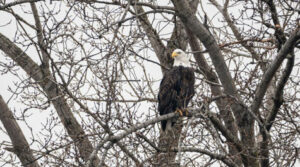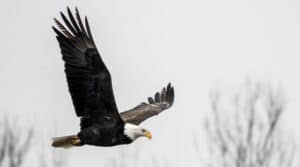A powerful symbol of conservation action

Guest author: David Clipner, Director of Education & Wildlife for the Leslie Science & Nature Center and the Ann Arbor Hands-On Museum
As one of the most recognizable birds in the world and America’s national bird, the bald eagle hardly needs an introduction. However, there are many misconceptions surrounding this iconic flyer and much to learn for all.
Is the bald eagle really bald?
The term “bald” is used in reference to an old English definition meaning “white” as opposed to meaning hairless. In fact, the scientific name for the bald eagle (Haliaeetus leucocephalus) translates as “white-headed eagle.” Juvenile bald eagles actually start their lives with mostly brown feathers, with some white mottled patches, and with dark beaks and eyes. Somewhere between four and seven years of age, juveniles mature; their head and tail feathers transition to white and their beaks and eyes transition to bright yellow.
What is a bald eagle?
Bald eagles are birds of prey, or “raptors,” that use their talons to grab their prey and their sharp, hooked beaks to tear away parts of their food. While most populations eat fish, bald eagles can be found throughout North America ,and their diet is dependent upon locally available prey. Even though bald eagles are very well-known and recognizable, they can sometimes be confused with other birds (particularly at their juvenile stage) such as the golden eagle (Aquila chrysaetos), which does not nest in Michigan but is of similar size and coloring and is often sighted during migratory seasons. The other is the turkey vulture (Cathartes aura),a scavenger with a distinctively wide wingspan that is a common sight in Southeast Michigan. It might surprise some folks to learn that, like the turkey vulture, the bald eagle is also a scavenger. Here in Michigan, you will find bald eagles hunting near rivers and lakes and also cleaning up roadkill along our highways. It is common to see turkey vultures and crows waiting for opportunities to pluck scraps once an eagle has gotten its fill.
Bald eagles: back from the brink!

In the 1960s, a popular insecticide called DDT had devastating impacts on many populations of wildlife. For eagles, their consumption of fish contaminated with DDT was causing the birds to lay eggs with shells that were abnormally thin. When adult birds would sit on their nests, they would crush their own eggs. This caused bald eagle populations to plummet. At one point, there were only around 400 nesting pairs in the lower 48 states. However, thanks to legislation that banned the use of DDT and protections afforded to bald eagles by the Endangered Species Act, the species has made a spectacular recovery. Today, we have an estimated 800 nesting pairs in Michigan alone!
Lead shot a continuing threat
The rebound of bald eagles is undoubtedly one of our greatest success stories in conservation. However, the continued use of lead ammunition in upland game hunting is poisoning these majestic birds. As frequent scavengers, eagles can consume the lead shot in animal carcasses left behind by hunters, and it only takes a small amount of lead to kill an eagle or another scavenger. Researchers have found lead in nearly half of all bald and golden eagles they tested throughout the Northern Hemisphere. Nearly a third of the birds tested showed signs of acute lead poisoning! Organizations like the National Wildlife Federation and Sporting Lead Free have resources for those interested in educating hunters about alternatives to lead shot.
It is extremely important to protect the bald eagle and many other species by protecting their habitats. By protecting habitats from pollutants and fragmentation, we also protect a long list of wildlife that may not necessarily be on an endangered species list. Today, we are fortunate to have the opportunity to see these amazing hunters of the sky in the wild. I see bald eagles hunting along the Huron River regularly and encourage you to keep an eye out for them.
—David Clipner, Director of Education & Wildlife for the Leslie Science & Nature Center and the Ann Arbor Hands-On Museum
This blog post was originally published March 1st in the Huron River Report, Spring 2022.



